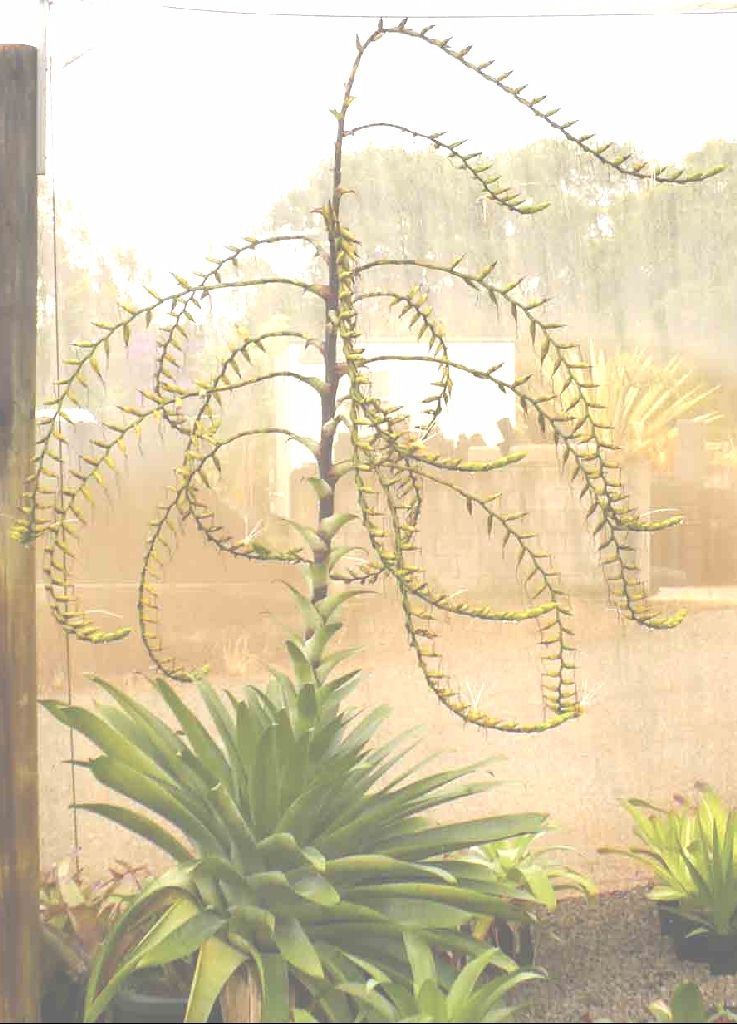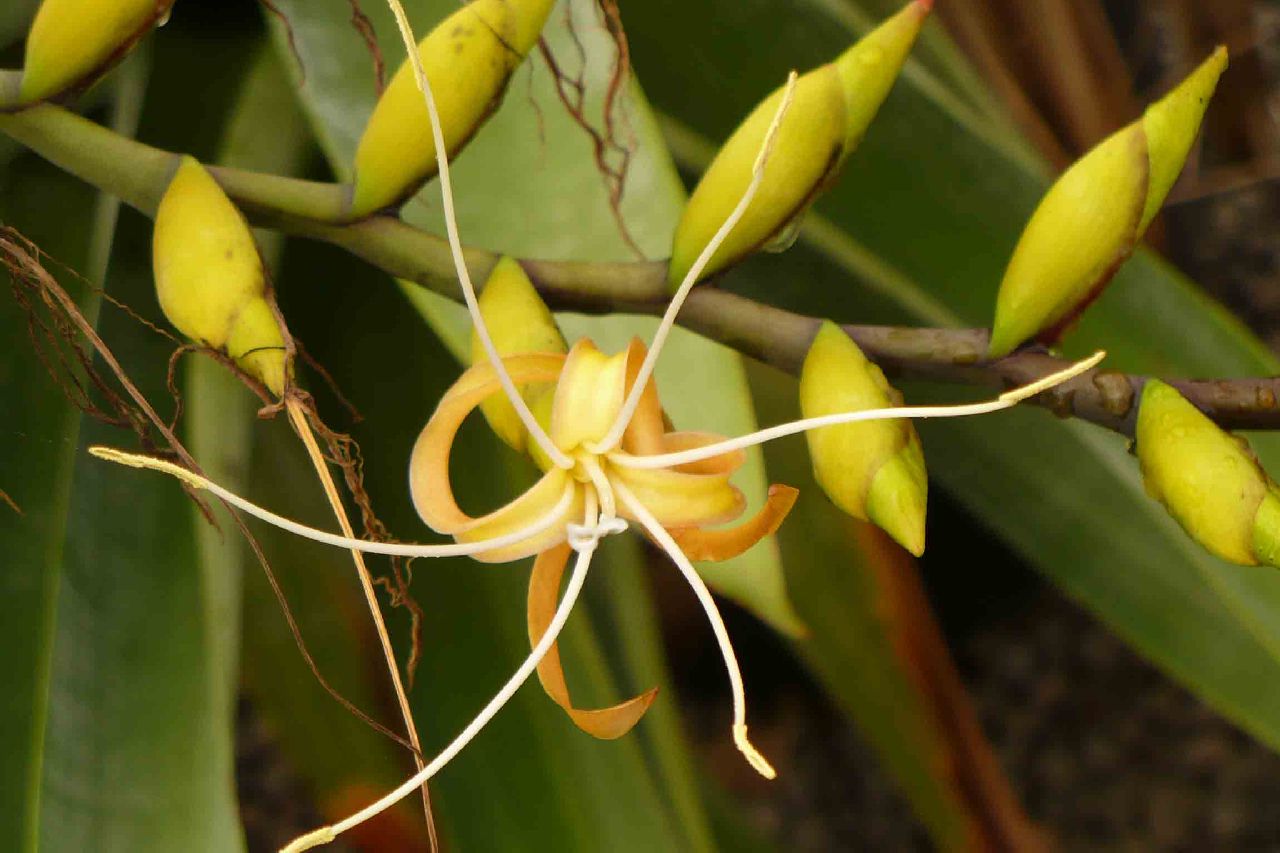

DIAGNOSE. This new species is related to Alcantarea extensa (L.B. Sm.) J.R. Grant, but differs by the linear triangular shape of the leaf blade (vs. ligulate in A. extensa), longer (> 120 cm vs. <110 cm) and stouter peduncle, which usually is purplish to almost black (vs. green to reddish wine red), 1.5-1.75 m wide inflorescence (vs.0.3-0.5 m) bearing larger number of branches (11-18 vs. 1-9), sterile and floral bracts predominantly green or yellowish green (vs. castaneous), narrower (2.5-3.5 cm), slightly gibbous, paleaceous and elliptic floral bract (vs. wider 3.5-4.6 cm, gibbous, coriaceous, broadly ovate), longer petals (12-13 vs. 8-9 cm) and longer filaments (11-13 vs. 7-9 cm).
Translated by Derek Butcher
ALCANTAREA AUSTRALIANA Versieux & Smythe, spec. nov. Bromelias Gig. Do Brasil 58-61. 2015
TYPE: BRASIL. Rio de Janeiro: Campos dos Goytacazes, Imbe, f. cult. na Australia a partir de semeadura, maio 2013, R. Little s.n. (holotype: UFRN17095!).
RUPICOLOUS (1.8) 2.3-3.2 m alt., short-caulescent.
ROSETTE 0.6-0.95 x 1.2-1.7 m, robust, infundibuliform, water retention developed.
LEAVES ca. 40, suberect, the oldest withering, forming a "skirt" around the rosette;
SHEATH 15-21 x (12) 18-20 cm, oval to oblong, dark brown to beige abaxially, beige to whitish adaxially in sicco, with oblique lines of whitish wax in direction of the apex, with purple to blackened spots abaxially in vivo, dense brown lepidote on both sides, coriaceous, margins membranaceous, hyaline-yellow;
BLADE 50-70 x 10-13 (at base) or 8-9 cm (middle), linear-triangular, reaching half the median width at the distal third, glaucous, green to yellowish-green adaxially, eventually purple-vinous stained at the base and spotted on the side or tip, with whitish wax bands on both faces and subdensely lepidote between the nerves abaxially, glabrous to sparsely lepidote in direction to the apex adaxially, straight to slightly arched, coriaceous, distinctly nerved, with prominent veins, margins without thin vinous lines;
TIP OF BLADE sharp, acuminatea, green, generally recurved, rarely twisted.
PEDUNCLE ca. 130 x 2.5-3 cm, erect, straight, cylindrical to slightly grooved, dark wine-colored to almost black, glabrous, distinctly nerved; internodes ca. 3.3-4.5 cm;
BRACTS proximal: subfoliaceous and suberect; the median and distal 8-10 x 5.5:-7 cm, ovate to wide-ovate, tip acuminate, green, with vinous spots at the base and the tip, usually waxy on the abaxial face, subdensely brown lepidote on both sides, erect to suberect, involute, accumulating a little water in the distal base often hiding beginnings of stunted branches, distinctly nerved, coriaceous, margins membranaceous, hyaline-yellow.
INFLORESCENCE 0.6-0.7 x 1.5-l. 75 m, compound, lax, a panicle of spikes, general outline elliptic, erect; rhachis internodes 7-8 cm;
PRIMARY BRACTS 7-9 x 7-8 cm, oval, tip acuminate or apiculate, green and vinous at the base and tip or wholly reddish, covered with wax or lustrous, the distal more glabrous abaxially than the proximal, involute, patent to suberect, much shorter (± 1/3) than the base of the lateral sterile peduncle, distinctly nerved-rugose, coriaceous, margins hyaline-yellow and membranaceous in sicco;
BRANCHES of INFLORESCENCE (7) 11-18, 14-42-flower, patent to sigmoid, the terminal longer (up to 1 m.) and strongly arched;
LATERAL PEDUNCLES 9.5-27 x 0.6-1 cm, slightly complanate, usually cylindrical, blackened passing to green, glabrous to inconspicuously lepidote;
STERILE BRACTS 2.5-3.5 x 2.6 cm, 2-4 (6), elliptic, tip obtuse, paleaceous in sicco, yellowish-green in vivo, glabrous abaxially, dense brown lepidotes adaxially, distinctly nerved, carinate, remote, chartaceous, margins hyaline-yellowish, membranaceous in sicco;
RACHILLA 90-100 cm, geniculate, green to vinous, glabrous or almost; internodes 1.8-4.5 x 0.6-0.7 cm;
FLORAL BRACTS 3.1-3.9 x 2.8-3.8 cm, elliptic to rounded, tip obtuse, paleaceous in sicco, yellowish green in vivo, glabrous abaxially, glabrous to sparsely brown lepidote in direction to the tip adaxially, partially enclosing the calyx, suberect, finely nerved-rugose in sicco, chartaceous, ecarinate, slightly gibbose, margins membranaceous, hyaline yellowish.
FLOWERS distichous or inconspicuously secund, anthesis at night, odourless
SEPALS 4.2-4.9 x 1.6 cm, elliptic, tip obtuse, symmetric or almost, exceeding the floral bracts by ca. 1.3 cm, green with yellow tip, sparsely lepidote abaxially, subdensely lepidote adaxially, coriaceous, ecarinate, margins membranaceous, hyaline-yellow in sicco;
PETALS 12-13 x 0.9-1 cm, ligulate, tip obtuse, constricted around the top of the sepals, with spots and small vinous traces on the abaxial face, yellow-orange adaxially, recurved and much spiraled in anthesis;
PETAL APPENDAGES ca. 38 x 4 mm, ligulate, longitudinally adnate to the petal, 8 mm free distally, tip obtuse, slightly asymmetric;
STAMENS in a bundle around the pistil at the time of anthesis, passing to divergent radial approx. 4 pm on the clock, then diverging, defining a circle of approx. 10 cm diam.;
FILAMENT 11-13 cm x 2 mm, flat on the base, cylindrical, white; ANTHER 15-20 x 2 mm, linear, yellow, dorsifixed proximo); STYLE 135 x 2 mm, cylindrical to slightly angular, white;
STIGMA LOBES ca. 6 x 1 mm, suberect passing to patent, white;
OVARY ca. 13 mm (portion superior) x 6 mm, narrow ovoid, whitish green.
CAPSULE ca. 5 cm x l-1.3 cm, ovoid, dark-brown; SEED ca. 7 x 1 mm, spindle-shaped, dark brown almost black;
BASAL COMA ca. 6 mm, beige; APICAL COMA ca. 10 mm, beige.
Pl. 9, Map 5.
DIAGNOSIS. This new species is related to Alcantarea extensa (L.B. Sm.) J.R. Grant, but differs by the linear triangular shape of the leaf blade (vs. ligulate in A. extensa), longer (> 120 cm vs. <110 cm) and stouter peduncle, which usually is purplish to almost black (vs. green to reddish wine red), 1.5-1.75 m wide inflorescence (vs.0.3-0.5 m) bearing larger number of branches (11-18 vs. 1-9), sterile and floral bracts predominantly green or yellowish green (vs. castaneous), narrower (2.5-3.5 cm), slightly gibbous, paleaceous and elliptic floral bract (vs. wider 3.5-4.6 cm, gibbous, coriaceous, broadly ovate), longer petals (12-13 vs. 8-9 cm) and longer filaments (11-13 vs. 7-9 cm).
DISTRIBUTION, ECOLOGY AND CONSERVATION. Alcantarea australiana is known from two collections only, both from the city of Campos dos Goytacazes, Rio de Janeiro's northern region. Originally, seeds were collected in the District of Imbe in fields, and taken for cultivation in Australia. Other examples also were collected in the same city, but in the region of Morro de Itaoca. New studies in field is needed to evaluate the state of conservation, in spite of the collectors indicating that the populations are large, the region of morro do Itaoca has been suffering with the impacts of mining.
PHENOLOGY. Was collected with fruits in May.
ETYMOLOGY. The choice of the name has a double meaning: it pays homage to Australia, where parents of the new species were grown and initially studied by collector Robert Smythe, and for being in the A. extensa complex with a more southern distribution, reaching the State of Rio de Janeiro.
DISCUSSION. This new species described here shows that for a decade it has been cultivated in Australia, from seed collected in Brazil. It was being treated as a cultivar, Alcantarea "Imbe", which refers to the Type location. The description here prepared is based on material cultivated in Australia. However, the existence of a species of monumental Alcantarea, in the region, North of Rio de Janeiro, already had been indicated by other collections (Forzza 5129 RB, SP), obtained in the region of morro do Itaoca, in the same city (Pl. 9h), but with past inflorescences. This specimen was identified by Versieux (2009) as affinis A. patriae, because of leaf morphology and a branch of the inflorescence. However, after analysis of flower material in cultivation, it was observed that the flower has typical features of the complex A. extensa (Versieux & Wanderley 2010) and is distinguished from all others by its inflorescence which is wider than long, with long branches. It is species with great ornamental potential, especially for the divaricate stamens, which assume position almost entirely radial and delimiting a circle of ca. 10 cm of diameter. The nocturnal flowers are odorless and the position of the stamens suggest pollinisation by bats. In connection with growing aspects, the species differs from other A. extensa complex by having attenuate leaves more densely arranged and with acute tip.
PARATYPE: Brasil. RIO DE JANEIRO: Campos dos Goytacazes, Morro do Itaoca, 27 May 2008, Forzza et al. 5129 (RB, SP).